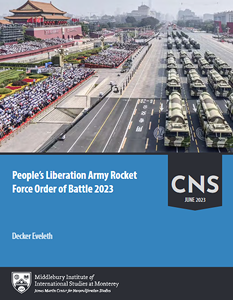Decker Eveleth

The People’s Republic of China is currently in the process of radically expanding its arsenal of conventional and nuclear land-based missile launchers. Over the past decade China has doubled the number of combat missile brigades in the People’s Liberation Army Rocket Force (PLARF), and has unveiled a myriad of new capabilities, including missiles capable of firing both conventional and nuclear warheads, and missiles equipped with hypersonic glide vehicles designed to evade missile defenses. The technologies and deployment patterns of these weapons are important indicators of the direction of China’s force posture: they not only indicate China’s military capabilities, but also its fears and its conceptions about how future wars in the region will be conducted. Deployment of particular systems with certain capabilities to certain regions can inform us of what, how, and when China might strike certain targets, which in turn can help us understand what China prioritizes as a threat. The current expansion of China’s missile forces suggests a possible departure from China’s previously restrained second-strike nuclear posture to a posture capable of deterring at multiple levels of conflict and an increased shift towards nuclear warfighting. As the Sino-American relationship becomes increasingly volatile over the status of Taiwan, gaining accurate data on China’s conventional and nuclear missile forces becomes more important than ever.
Since China first established a ballistic missile force, that force has historically been quite small, kept at low levels of readiness, and constrained by a policy forswearing the first use of nuclear weapons. A little over a decade ago, China only possessed around 50 intercontinental ballistic missiles (ICBMs), of which only the 18 DF-5 ICBMs in silos and 12 DF-31A mobile launchers could reliably reach the contiguous United States. 1 After Xi Jinping elevated China’s missile forces into a full branch of the People’s Liberation Army in 2015, the number of missile launchers deployed by the PRC has increased rapidly. The PLARF, responsible for the operation of all non-tactical ground-based surface-to-surface missile systems in China’s inventory, operates both conventional and nuclear missiles for a variety of strategic missions. This could include utilizing short, medium, and intermediate-range missiles to neutralize Taiwanese defensive installations, striking US warships at long-range while those warships are at sea or in port, or a retaliatory nuclear strike mission. The PLARF is now on track to deploy more than 1,000 ballistic missile launchers by 2028, including at least 507 nuclear capable launchers, 342 to 432 conventional launchers, and 252 dual-capable launchers. At least 320 solid-fueled fixed ICBM silos and 30 liquid-fueled fixed ICBM silos are currently under construction in addition to China’s growing arsenal of mobile ICBM launchers. And this tally does not even touch launchers operated by the People’s Liberation Army Air Force (PLAAF) and the People’s Liberation Army Navy (PLAN).
The dramatic multiplication in missile forces, both in terms of those missiles capable of reaching the United States, and those missiles that offer China new capabilities in a regional war, have serious implications for the strategic balance in East Asia as well as the future direction of China’s nuclear posture. The direction of the posture is difficult to assess due to the lack of sources coming out of China. As the Chinese government has not officially commented on the buildup or acknowledged its scope, any concrete data, like statements and records from the PLARF itself or Chinese strategists, is hard to come by. Because of this, analysis of what the PLARF is actually deploying and in what quantity is one of our only windows into developments into how the PRC thinks about its nuclear weapons arsenal and how to use it. Open-source intelligence techniques allow researchers to collect this data. By utilizing publicly available information and commercial satellite imagery, researchers can examine foreign military organizations in a level of detail that was previously only available to state intelligence agencies. Read the full report
No comments:
Post a Comment